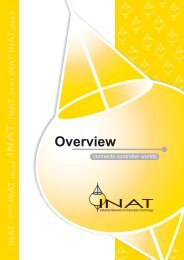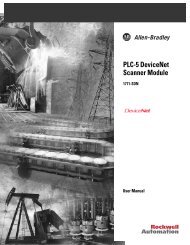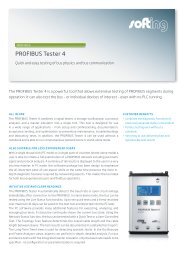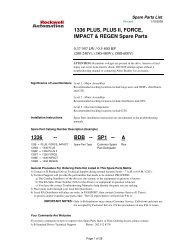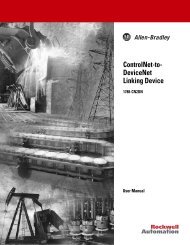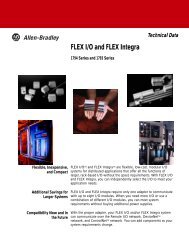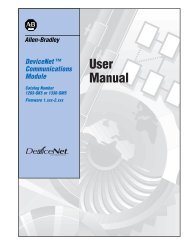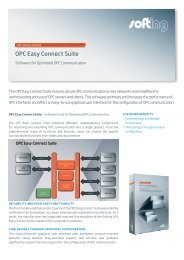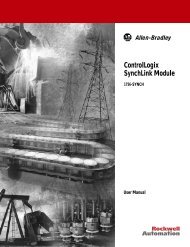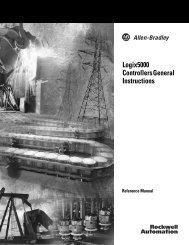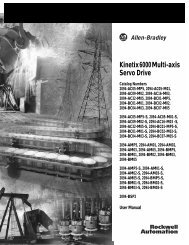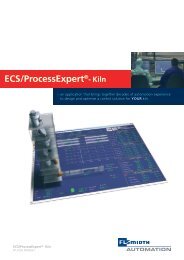FLEX I/O EtherNet/IP Adapter Module User Manual, 1794-UM006A ...
FLEX I/O EtherNet/IP Adapter Module User Manual, 1794-UM006A ...
FLEX I/O EtherNet/IP Adapter Module User Manual, 1794-UM006A ...
Create successful ePaper yourself
Turn your PDF publications into a flip-book with our unique Google optimized e-Paper software.
3-2 Configuring the <strong>1794</strong>-AENT <strong>Adapter</strong> for Your <strong>EtherNet</strong>/<strong>IP</strong> Network<br />
Configuration<br />
Requirements<br />
Ethernet Address (MAC)<br />
Class A<br />
Class B<br />
Class C<br />
Publication <strong>1794</strong>-<strong>UM006A</strong>-EN-P - July 2001<br />
Before you can use your <strong>1794</strong>-AENT adapter, you must configure its<br />
<strong>IP</strong> address, and optionally, its subnet mask and gateway address. You<br />
can use the Rockwell BootP utility to perform the configuration. You<br />
can also use generic BootP software or, within some limitations, a<br />
DHCP server.<br />
IMPORTANT<br />
<strong>IP</strong> Address<br />
When using the BootP protocol, you must enter the<br />
Ethernet hardware address of your adapter. Rockwell<br />
assigns each <strong>1794</strong>-AENT adapter a unique 48-bit<br />
hardware address at the factory. The address is<br />
printed on a label on the front of your <strong>1794</strong>-AENT<br />
adapter as shown in the figure at left. It consists of<br />
six hexadecimal digits separated by colons. This<br />
address is fixed by the hardware and cannot be<br />
changed.<br />
If you change or replace the <strong>1794</strong>-AENT adapter, you<br />
must enter the new Ethernet hardware address of the<br />
adapter when you configure the new adapter.<br />
The <strong>IP</strong> address identifies each node on the <strong>IP</strong> network (or system of<br />
connected networks). Each TCP/<strong>IP</strong> node on a network (including the<br />
<strong>1794</strong>-AENT adapter) must have a unique <strong>IP</strong> address.<br />
The <strong>IP</strong> address is 32 bits long and has a Net ID part and a Host ID<br />
part. Networks are classified A, B, C, (or other). The class of the<br />
network determines how an <strong>IP</strong> address is formatted.<br />
0<br />
0<br />
0<br />
1 0<br />
0<br />
1 1 0<br />
Net ID<br />
Net ID<br />
8 9<br />
16 17<br />
Host ID<br />
Host ID<br />
24 25<br />
Net ID Host ID<br />
You can distinguish the class of the <strong>IP</strong> address from the first integer in<br />
its dotted-decimal <strong>IP</strong> address as follows:<br />
Range of first integer Class Range of first integer Class<br />
0 -127 A 192 - 223 C<br />
128 -191 B 224 - 255 other<br />
31<br />
31<br />
31




